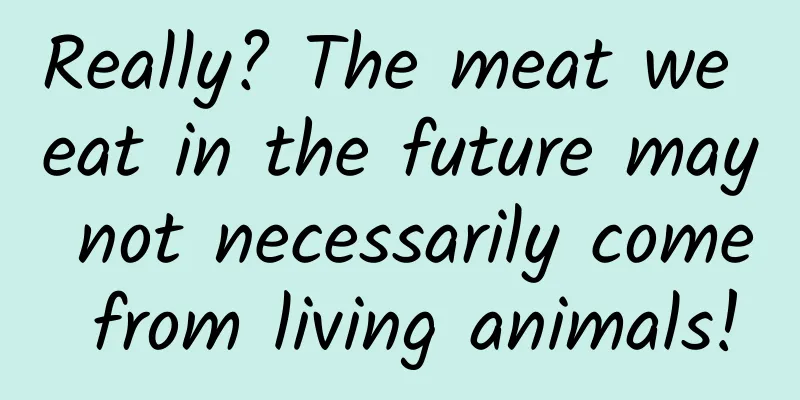Really? The meat we eat in the future may not necessarily come from living animals!

|
□ Shan Shouqing The steamed buns invented by Zhuge Liang, the dumplings first created by Zhang Zhongjing, the first bowl of Dongpo pork stewed by Su Dongpo... People eat a lot of traditional foods, so they naturally know a lot about them. However, innovative foods that keep pace with the times and their raw material sources, production techniques, and eating methods are often poorly known, or even unknown. For example, future food. The "future" of future food is not as easy to understand as the "flavor" of flavored food, the "old age" of elderly food, and the "health" of health food. The future is a concept of time relative to the past and the present. There is a comprehensive discipline that studies the future called futurology. There is an industry with high growth, strategic and leading characteristics called future industry. As a research object of futurology and a component of future industry, what kind of food is future food? Chen Jian, an academician of the Chinese Academy of Engineering and chief scientist of the Future Food Science Center of Jiangnan University, said in his "Scientists Doing Science Popularization": "The properties of future food are representative substances of future changes in production methods and lifestyles. They mainly solve problems such as food supply and quality, food safety and nutrition, eating methods and spiritual enjoyment. The core contents include plant-based food, food perception, intelligent manufacturing, alternative proteins, precision nutrition, and food safety." In this way, the future development trend of the food industry will be the high integration of food technology, biotechnology and information technology, so that more healthy foods can be seen, trusted and accepted. Here we need to explain the "traditional eating habits". Traditional eating habits refer to a certain food ingredient that has a history of more than 30 years of production and operation as a fixed or non-fixed packaged food in the provincial area and is not included in the "Pharmacopoeia of the People's Republic of China". In today's food consumption, the past is gone, and the future is here. Some people have already enjoyed the future foods developed by scientists and experienced that they are safer, more nutritious, more convenient, tastier and more sustainable. Although artificial meat is 100% plant-based, it has the appearance, smell and taste of animal meat; plant milk is made from nuts (almonds, cashews, coconuts, etc.) or grains (oats, buckwheat, soybeans, rice, etc.), which is very suitable for vegetarians and people who are allergic to animal protein; printed food, with the help of food printers - "food ink" - hydrocolloids (substances that can produce gels and keep water inside, containing starch, pectin, gum and agar) - print out foods collectively called "future foods"; food capsules, mix nutrients such as protein and vitamins together and put them into capsules. For a meal, you only need to swallow a few capsules. It is nutritionally balanced and will not make people fat. Not long ago, in a future food laboratory in Zhejiang, cell-cultured fish meat that had been "grown" for 17 days was unveiled: milky white in color, soft in texture, and slightly fishy in taste, it is very similar to real yellow croaker meat. At the key technical achievement appraisal meeting of biosynthetic cell-cultured fish meat specially held for this purpose, experts unanimously agreed that: the project researchers conducted comparative studies on the appearance, cell number, ratio of muscle cells and fat cells, hardness, viscosity, elasticity and other characteristics of biosynthetic cell-cultured fish meat with the muscle tissue of real yellow croaker. The research results have reached the international advanced level, and the core technology has reached the international leading level, providing new ideas for the future development of "artificial meat" of different fish and even cell culture of other economic animals to obtain high-quality protein. With the continuous deepening of technology, it will surely be able to be mass-produced in the foreseeable future, so that cell-cultured fish meat can be put on people's tables. Therefore, the successful development of the first artificial yellow croaker meat in my country further proves that future food can reduce the high dependence of artificially farmed meat animals on land and water resources. In other words, the meat that humans will eat in the future will not all come from living animals that walk on the ground, swim in the water, or fly in the sky, but also from "factory farming". In the process of pursuing health, safety, and environmental protection in people's diet and life, the changes in food-related concepts such as "green food", "smart food", and "future food" have emerged... The future of food is just around the corner. Faced with the many "unknowns" about future food, food science popularization will surely play a big role. (The author is the chairman of the Food Science Creation Professional Committee of the China Science Writers Association and a master of Chinese catering culture) |
Recommend
Deeply debug network requests using WireShark
background Recently, I found that our product has...
App promotion is at a bottleneck? 7 ways to solve your problems!
We all know the importance of App marketing . If ...
How much does it cost to develop a Chifeng jewelry mini program? What is the price quote for Chifeng jewelry mini program customization?
How much does it cost to develop a jewelry mini p...
Which self-media platform is the best? 2018 self-media platform recommendation
In the past 2017, the self-media industry has ach...
A detailed explanation of the marketing and promotion methods of Internet finance from 5 cycles!
This article will reveal the underlying logic of ...
How much does it cost to recruit investors for the Hanzhong Underwear Mini Program?
Hanzhong underwear mini program investment promot...
Did Yutu crash due to speeding? How is that possible?
"Yutu was damaged by racing?" There are...
How to optimize account structure knowledge? What is the basic structure of a bidding account?
Many people don’t know how to optimize a Baidu pr...
How can cash loan products effectively improve conversion rates under high traffic costs?
To improve conversion rate is to improve user exp...
How much do you know about illegal poachers who are hated by the whole world?
Let's first look at some data: In 2014, the p...
No chance to charge? Gionee M5 review with 6020mAh large battery
What do you value most when buying a mobile phone...
Why do I still get lung cancer even though I don't smoke or drink? Pay attention, this type of lung cancer has already targeted women
Spot check! Name a group of people at high risk f...
Annual output reaches 2 billion cubic meters! This 100 billion cubic meter gas field in the Sichuan Basin heads southwest
According to the Sinopec News Office, another 100...
The mobile phone market is saturated and needs to be transformed. HTC wants to make a comeback with VR?
On April 26, the virtual reality device HTC VIVE ...
The "rice popcorn" that the birds in the trees love to eat, don't try it blindly|Expo Daily
The sky is crowed and the rice flowers are bloomi...









